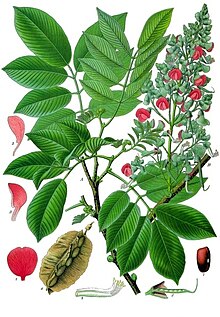| Florida fishpoison tree | |
|---|---|

| |
| Scientific classification | |
| Kingdom: | Plantae |
| Clade: | Tracheophytes |
| Clade: | Angiosperms |
| Clade: | Eudicots |
| Clade: | Rosids |
| Order: | Fabales |
| Family: | Fabaceae |
| Subfamily: | Faboideae |
| Genus: | Piscidia |
| Species: | P. piscipula[1]
|
| Binomial name | |
| Piscidia piscipula[1] (L.) Sarg.
| |
| Synonyms | |
|
Piscidia erythrina L. | |
Piscidia piscipula, commonly named Florida fishpoison tree, Jamaican dogwood, or fishfuddle, is a medium-sized, deciduous, tropical tree in the Fabaceae family. It is native to the Greater Antilles (except Puerto Rico), extreme southern Florida (primarily the Florida Keys) and the Bahamas, and the coastal region from Panama northward to the vicinity of Ocampo, Tamaulipas, Mexico.[3] The native Taino of the West Indies discovered that extracts from the tree could sedate fish, allowing them to be caught by hand.[3] This practice led to the tree's common names—fishpoison and fishfuddle. The tree has medicinal value as an analgesic and sedative.[4]
The generic name is Latin for "fish killer", and the specific epithet is Latin for "little fish".[5]
- ^ USDA, NRCS (n.d.). "Piscidia piscipula (L.) Sarg.". The PLANTS Database (plants.usda.gov). Greensboro, North Carolina: National Plant Data Team. Retrieved 15 June 2022.
- ^ IUCN SSC Global Tree Specialist Group; Botanic Gardens Conservation International (BGCI) (2020). "Piscidia piscipula". IUCN Red List of Threatened Species. 2020: e.T156770819A156770821. doi:10.2305/IUCN.UK.2020-1.RLTS.T156770819A156770821.en. Retrieved 22 November 2022.
- ^ a b "Tropicos | Name - Piscidia piscipula (L.) Sarg". www.tropicos.org. Retrieved 2017-08-05.
- ^ Auxence, Elena Gautier (1953). "A pharmacognostic study of Piscidia Erythrina". Economic Botany. 7 (3): 270–284. doi:10.1007/BF02984953. S2CID 43081500.
- ^ Nellis, David N. 1994. Seashore plants of South Florida and the Caribbean: A guide to identification and propagation of xeriscape plants. Pineapple Press. 160 p.
